In this article we talk some more about how to make the the process of complex product designing can feel simple and easy to do.
Let’s look at some more tips to attain a firm hold over complexity in product design.
Look for a beginning and an end
What is a product? A product is simply a means to an end. The need for a product arises somewhere else and it finally lands up somewhere else. Getting wrapped up in the process of creating pixel-perfect designs and overlooking the beginning and the end is the mistake most designers make. It’s not possible all your users are looking at your product on a crisp retina screen, in a perfect sized window without interruption from any other source. It’s important to ask questions, “ Where is this information coming from?” and “Where does it go from there?”.
Finding answers to these questions are critical for understanding your app’s context. The complexity of the environment your product is in can have a big impact on your designs. It may so happen that your product is used on a desktop with 30 other windows open simultaneously. Ot it may be used outside on a tablet or for some other purpose which you may think is impossible.
Prioritize learnability and discoverability
When you download a new app for your phone, usually it’s window is very short to on board you and provide value or it’s dead. A consumer has a choice to use your product or 100 others like it, the reason why it’s crucial to promote discoverability.
The same condition applies to business-class software too. As marketers there’s always the fear that users won’t locate a particular feature, so it should be made more prominent or should be highlighted more. And that happens repeatedly then it’s bound to get complex and messy.
And that’s when learnability plays it’s part. Not every feature needs to blast you in the face to be usable. It can be learned through interaction. Complex systems require prioritization of features at the expense of visibility to others.
Maintain clarity and cleanliness
Too much information on the page and the users is bogged down. Too little and it starts seeming hard to reach meaningful insights. So how do you strike the right balance?
Cleanliness
If the situation arises where you have to cram a lot of information into a small space, but it’s not critical to have in all on-hand then we recommend a progressive reveal strategy for decluttering the UI. By progressive strategy we mean the user’s interest automatically drives information fidelity. The information in the UI gets a structure so only the core elements are visible. The track is speed to insight and what you get is a cleaner less cluttered UI.
Clarity
On the other hand, some products demand a high-level of data visibility for the purpose to be served. E-commerce, healthcare and finance are industries with the reputation of having notoriously complex products.
When data density is a major concern, then you have to be meticulous about clarity. Utra consistency and crispness with the visual language are the keys here.
Measuring accurate consistency means exercising extreme constraint with the following:
● Type variations
● Button styles
● Simple navigation systems
And also adopt a systematic approach to
● Color choices
● Labeling
● Even the microcopy
All these work together to add up to an elegant solution.
With time design has evolved in pretty exciting ways with the changes in device, apps and access to data. The scope of interaction and development is growing by the day and with that comes an even greater need to manage complexity.





